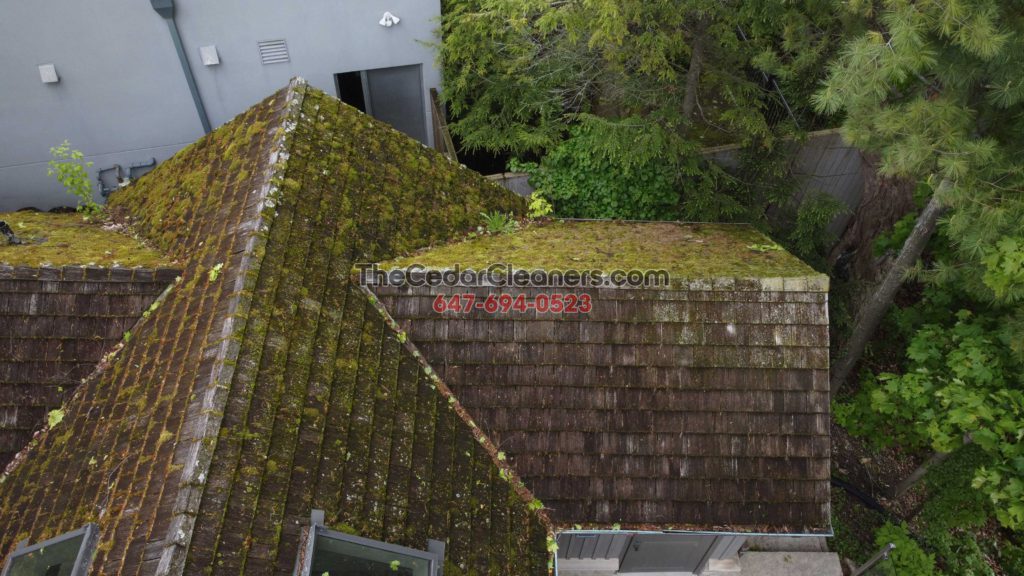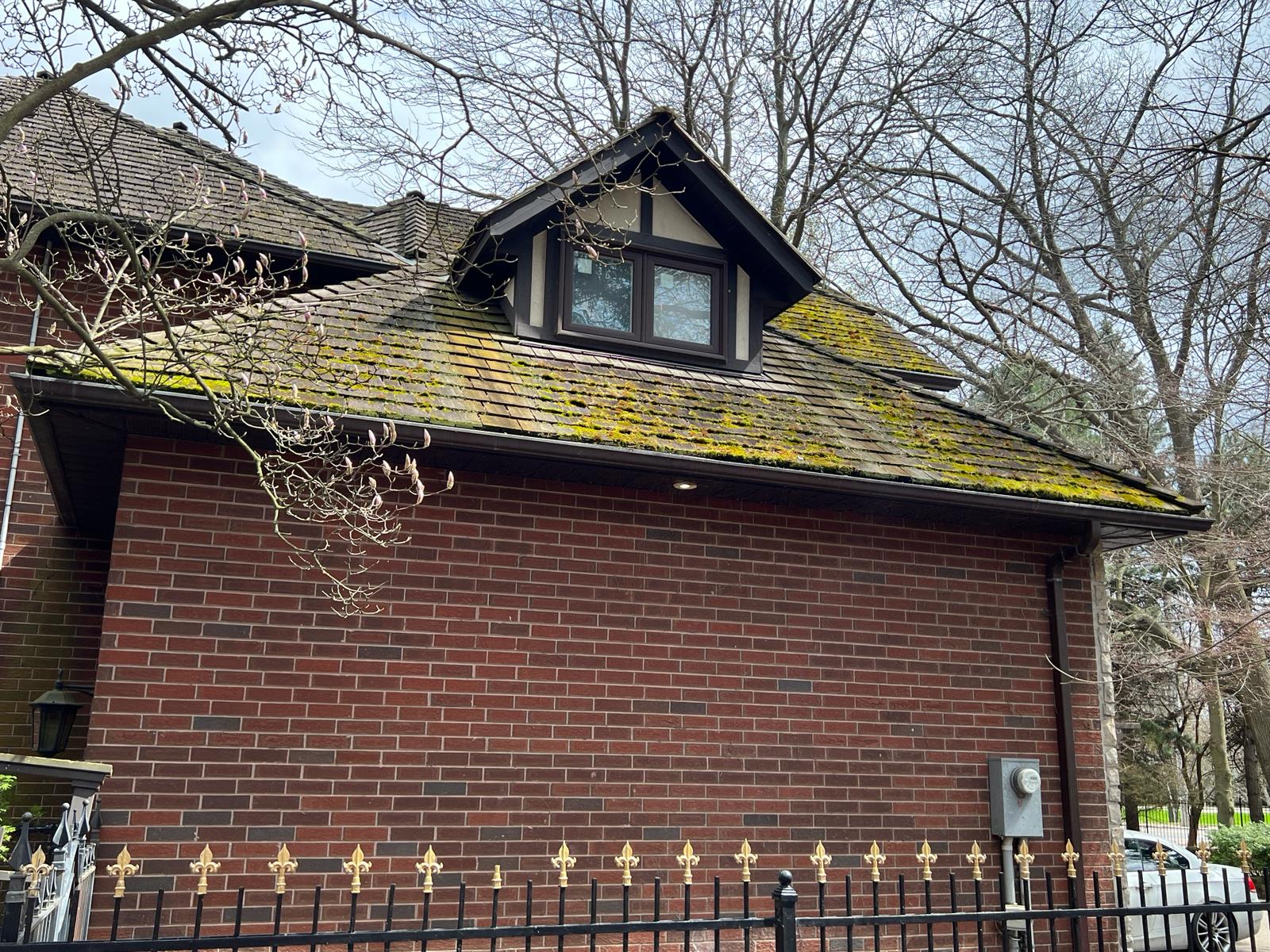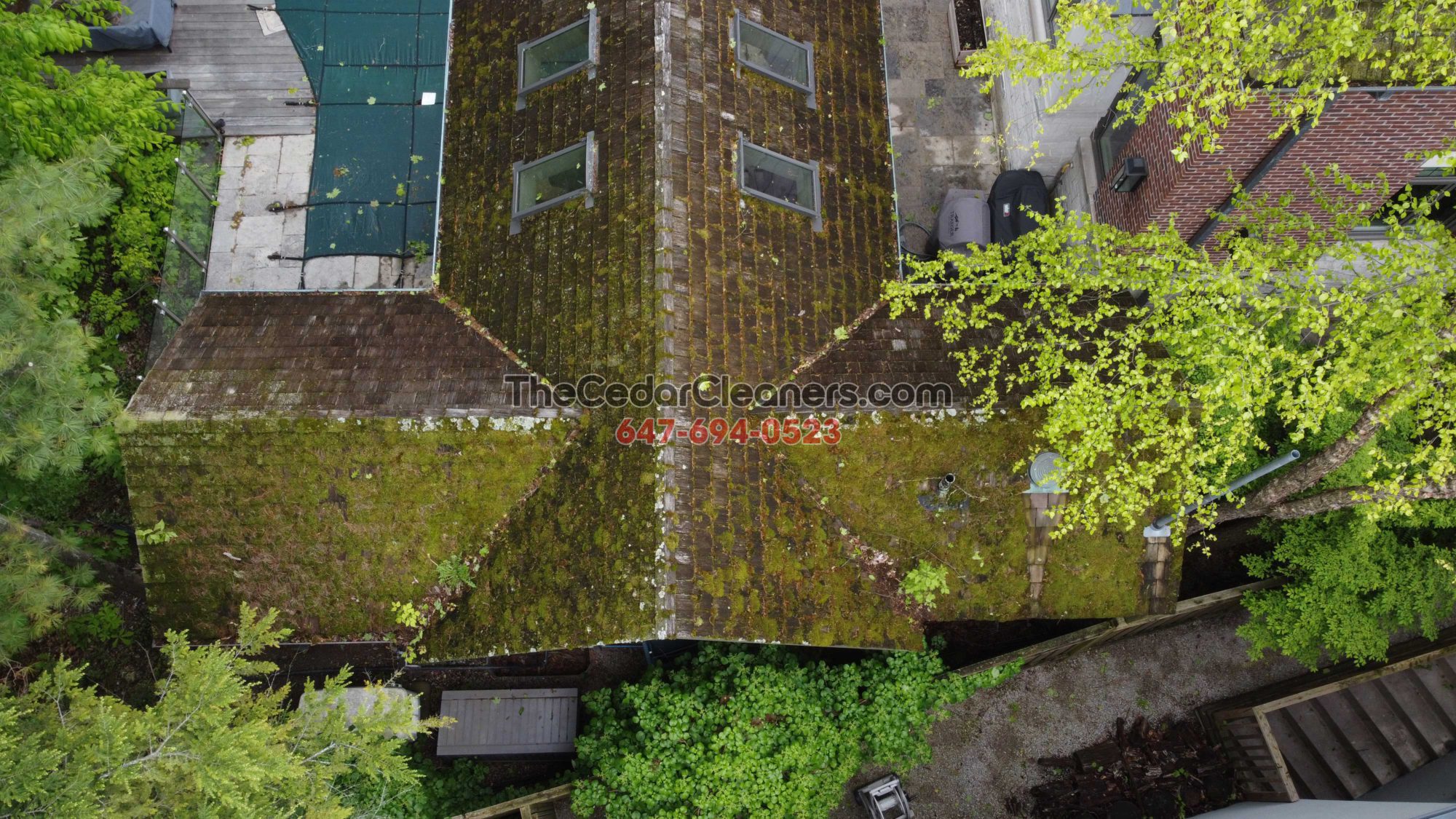Going green is always in style—unless it’s moss growing on your roof. For homeowners in Toronto, the Greater Toronto Area (GTA), and across the scenic Niagara Region, roof moss is more than just an eyesore. It’s a silent destroyer of shingles, tiles, and even your wallet.
In Ontario’s shaded, tree-lined neighborhoods and moisture-heavy microclimates—particularly on north-facing rooftops—moss thrives. It grows rapidly, creeping between roof materials, lifting them, and making way for rainwater, snowmelt, and debris to wreak havoc underneath.
Roof Moss removal
To help you make an informed, responsible choice, the experts at The Cedar Cleaners share their professional insights on the most common moss killers on the market, what to avoid, and what works best in our local climate.

Zinc Sulfate: The Popular But Problematic Option
Zinc sulfate is commonly marketed under the name Moss Out and widely used by roofing contractors and DIYers alike across southern Ontario. It’s cheap and fairly effective—but that doesn’t make it safe.
The risks of zinc sulfate:
- It’s a heavy metal that bioaccumulates, which means it doesn’t easily break down in the environment.
- It is not regulated for moss treatment in Ontario, which leads to frequent overapplication.
- It creates toxic runoff that washes into groundwater and storm drains—impacting Lake Ontario, the Niagara River, and local ecosystems.
You can often spot a zinc sulfate-treated roof by the white, chalky residue that appears after it has been overused. If you can see the treatment from the curb, it was overdone.
At Wilderland, we avoid zinc sulfate altogether—choosing instead to use organic, non-toxic moss treatments that are safe for both your home and the environment.
Copper Sulfate: Effective, But Harmful to the Ecosystem
Another chemical solution commonly found in hardware stores and used by some contractors is copper sulfate. While it does eliminate moss, it’s not without serious consequences.
Why we don’t recommend copper sulfate:
- Like zinc, copper is a heavy metal that doesn’t degrade in soil or water.
- It poses a significant threat to aquatic life and can harm local fish populations in the GTA’s rivers and Niagara’s wetlands.
- Repeated exposure can contaminate your lawn and garden, creating long-term soil toxicity.
For residents near Toronto’s ravines or Niagara’s escarpment zones, this risk isn’t theoretical—it’s local, real, and avoidable.
Zinc Strips: A Short-Term Fix with Long-Term Frustrations
Some companies install zinc strips near the peak of a roof as a passive moss prevention system. These strips release zinc ions when it rains, creating a zone where moss can’t grow.
The problem with zinc strips?
They lose effectiveness within 2 to 3 years due to oxidation. After that, they’re nothing more than a visual blemish—and a removal project. Worse yet, they require nailing into your roof, which can create unnecessary holes and weak spots in your shingles.
At Wilderland, we’ll remove zinc strips upon request—but only when it can be done safely, without compromising your roof’s structure.
Our Organic-Certified Treatments: Safe, Smart, and Sustainable
In the Niagara Region, where lush foliage and historic homes meet lake-effect weather, eco-safe roof care is more than a trend—it’s a necessity. That’s why Wilderland exclusively uses certified organic treatments that are as effective as they are environmentally friendly.
Sodium Carbonate Peroxyhydrate: The Granular Powerhouse
Also known as granular hydrogen peroxide, this solution is sprinkled across the roof. When it encounters moisture—whether from dew, rain, or humidity — it activates and oxidizes the moss’s protective coating.
- It effectively dehydrates and destroys moss without harming your shingles.
- The compound breaks down into oxygen and water, leaving no toxic residue.
- It’s ideal for areas with high tree coverage like Etobicoke, Richmond Hill, or Niagara-on-the-Lake.
This granular treatment is especially recommended for older heritage homes where the roofing materials require gentle, non-invasive care.
d-Limonene: Citrus-Based Liquid That Works Fast
Our preferred liquid treatment contains d-limonene, a natural extract from citrus peels. This powerful but safe cleaner strips away the waxy surface of moss, causing it to wither and die within hours.
- It’s plant-safe and pet-friendly.
- There’s no runoff risk to gardens, lawns, or nearby waterways.
- Clients in Oakville, Hamilton, and St. Catharines often report visible results the same day.
Plus, the natural citrus scent is a refreshing change from the chemical smell left by traditional moss killers.
Why Moss Removal Matters More in Toronto, GTA, and Niagara
In our region, moss is more than seasonal—it’s structural. Whether you’re dealing with the tree-covered hills of the Niagara Escarpment, Toronto’s urban canopy, or Mississauga’s suburban sprawl, moss grows where moisture lingers.
And while it might seem like a minor cosmetic issue, moss can:
- Shorten your roof’s lifespan by 10–15 years
- Cause leaks that damage ceilings and insulation
- Promote rot in wooden roof decks
- Void warranties on certain roof materials
That’s why Wilderland’s roof care solutions are designed with both durability and sustainability in mind—especially for Ontario homeowners who care about their property and their environment.

Moss Removal Get Your Free Estimate
Choose Smart, Choose Local, Choose Safe
So, what is the best moss killer for roofs in Toronto, the GTA, and the Niagara Region?
Skip the heavy metals.
Avoid shortcuts that fail long-term.
Choose organic-certified solutions like Sodium Carbonate Peroxyhydrate and d-limonene.
With Wilderland’s locally focused, eco-conscious approach, your roof gets the care it needs—and so does your community.

